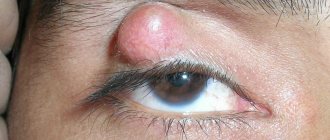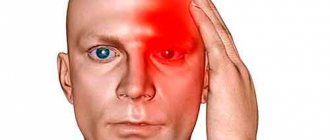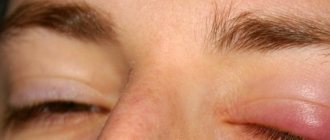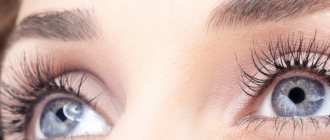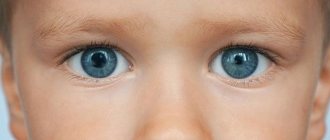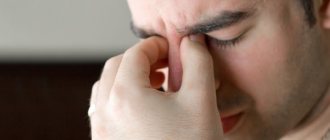Headaches in the forehead area are very unpleasant and can become an obstacle to a person’s normal activities. They have different reasons, it should not be underestimated. Frequent attacks of cephalgia reduce the quality of life and may indicate a serious illness. If you haven't had headaches before and suddenly start experiencing persistent pain, consult your doctor. A visit to a specialist is also required if there is severe pain between the eyebrows or the intensity of the migraine suddenly worsens.
Typical nature of pain between the eyebrows, above the eyes
There are 4 types of cephalgia, each with different causes and symptoms. Determining the type of headache is the first step to solving the problem:
- Tension. With this type, the headache occurs in the area of the temples, in the frontal region, or between the eyes. The soreness is characterized as a hoop around the head. The intensity is practically unchanged and does not increase.
- Migraine. With a migraine, a person feels a throbbing pain in the head on the left or right side, accompanied by nausea and hypersensitivity to light. Visual disturbances (flashes of light, zigzag lines in the field of vision) may also appear.
- Cluster. A person experiences sudden, intense (often unbearable) pain around the eye on one side.
- Attacks caused by sinusitis. Sinusitis manifests itself as a dull, throbbing pain in the forehead and eyebrows, above the nose (in the bridge of the nose). Pressure may also be felt above the eye under the eyebrow. The pain intensifies when the head is tilted.
Pain between and above the eyebrows - what could cause this?
To favorites
Almost every person with the flu or cold experiences pain between the eyes and eyebrows, in other areas of the forehead and head. These symptoms are common and rarely cause concern. But they can also indicate other, more serious diseases, so it is advisable to learn to recognize them in order to see a doctor in time.
Only a doctor can determine the exact cause of pain
Headache, depending on the location, duration and severity, can be a symptom of a variety of diseases:
- When the forehead hurts between the eyebrows + there is no runny nose, this may indicate stress, overwork, and psychological tension. Over time, the pain spreads to the eyes, temples, and the back of the head, often accompanied by nausea, dizziness, and even loss of coordination.
Common causes of physical ailments are stress and neuroses
- It can also be a symptom of increased intracranial pressure. Most often it occurs in people with blood pressure problems - hypotensive and hypertensive people, as well as weather-dependent people.
Advice. If you belong to this category, get a tonometer so you can measure and control your blood pressure with your own hands.
- A sharp throbbing pain, accompanied by lacrimation and redness of the eyes and which does not decrease for a long time even after taking painkillers, is called fascicular pain. Its cause is problems with blood vessels, and the factors that provoke the onset of an attack are most often climate change, drinking alcohol, and smoking.
Cluster pain usually plagues middle-aged and older men with nicotine addiction
- Migraine, familiar to many women. In this case, the headache is not always between the eyebrows; more often the pain is one-sided, radiating to the eye and temple, accompanied by severe nausea, leading to vomiting.
Migraine is a common problem among women
- The already mentioned flu is the most common cause of headache , during which it can be difficult to even move your eyes or endure bright light. A similar condition, along with aches in muscles and joints, fever, and weakness, occurs with other infectious diseases: malaria, typhoid, acute meningitis, etc.
- You can suspect neuralgia or trigeminal neuritis if your head and left eyebrow hurt in the absence of a runny nose and normal body temperature, and when you press on your eyebrows the pain intensifies. Additional symptoms are redness of the skin in the forehead and watery eyes.
But it is especially important when pain occurs in the central part of the forehead to exclude such dangerous diseases as sinusitis and frontal sinusitis. They should be described in more detail.
These are diseases associated with inflammatory processes in the frontal and maxillary sinuses. They often run in parallel.
The course of the disease can be divided into three phases: initial, acute and chronic. Each of them is characterized by special symptoms in addition to the fact that it hurts above the nose between the eyebrows.
The photo shows the location of the frontal sinuses, the inflammation of which leads to pain
Note. Most often, inflammation of the frontal sinuses becomes a consequence of improper or insufficient treatment for a runny nose, colds, or flu. Or when the disease is carried “on your feet”.
| Initial phase | Acute course | Chronic course |
| Nasal congestion | A feeling of heaviness and severe pain between the eyebrows, further intensified by pressing or tilting the head, or moving the eyes. | Signs of the disease are mild. |
| Mucous discharge mixed with pus from the nose. | Copious purulent discharge from the nose with a strong unpleasant odor, especially in the morning and afternoon. | Inflammatory processes, as the cause of pain between the eyebrows, spread to nearby sinuses. |
| Painful sensations between the eyebrows and in the bridge of the nose. | A sharp increase in temperature to 390C and above. | The pain may come and go periodically. |
| General weakness. | The appearance of a cough due to mucus flowing down the walls of the larynx from the inflamed sinuses. | |
| Temperature rises to 37-37.50C. | Lack of appetite, sleep disturbances, apathy. |
The easiest way to cure frontal sinusitis is at the initial stage. To do this, you need to regularly get rid of mucus using nasal rinsing with saline solution or special means.
Aquamaris nasal rinsing device
If you “seize the moment”, you can do without special drugs, the price of which is quite high, using only symptomatic treatment. For example, relieving fever, headache and muscle pain with regular aspirin or Pentalgin.
In the acute phase, rinsing alone is not enough, although they are also necessary, since the source of inflammation must be eliminated. In addition to them, you will need to take strong medications, and in advanced cases, surgery to free the frontal and maxillary sinuses from pus-containing contents. Of course, in such cases a hospital is needed.
Note. The main symptoms of acute sinusitis are similar to those of allergic frontal sinusitis, the treatment principle of which is different. Therefore, you should not self-diagnose and self-medicate - this should be done by a doctor.
At an appointment with an otolaryngologist
The disease develops into a chronic form if during its acute phase the frontal sinuses were poorly cleaned, incorrect treatment was prescribed, or it was not completed.
To treat frontal sinusitis of bacterial origin and sinusitis, antibiotics of the same group are usually used.
If an adult is able to understand why his forehead hurts between the eyebrows or, in case of serious illness, consult a doctor, then a child cannot always even say where and what hurts and how he feels. But even young children experience inflammation of the frontal sinuses, and even more so colds, viral and other infectious diseases.
They develop quickly, leading to serious complications, so it is very important to detect the symptoms of the disease in time and begin treatment immediately.
You can recognize frontal sinusitis or sinusitis in a baby by the following signs:
- the child becomes lethargic, irritable, capricious;
- he has sleep disturbances, difficulty in nasal breathing;
- body temperature rises;
- Appetite decreases, sometimes children refuse to eat altogether.
Such manifestations do not directly indicate the development of frontal sinusitis and may be symptoms of a common cold. But it is necessary to see a doctor in order to catch the disease in the initial phase.
A runny nose and fever are a reason to consult a specialist.
If this is not done, then it will progress. The child will have swelling on the face, the skin will become pale, the eyes will be red and watery, and a cough will occur, especially severe in the morning after getting out of bed. There is only one instruction: immediately go to the clinic or call a pediatrician at home.
No advice, recommendations, or medical reference books will help you accurately determine the cause of a headache in the forehead. And even if an eyebrow twitches, only a specialist can determine the cause based on a personal examination and data from laboratory and hardware tests. Sometimes this requires a whole consultation with the participation of a therapist, otolaryngologist, neurologist and even a dentist.
You can only temporarily alleviate the condition by taking a painkiller and ensuring yourself a calm and comfortable environment. If the situation repeats frequently or the pain gradually increases, do not delay contacting a doctor.
The video in this article will tell you why frontal sinusitis is dangerous and how to avoid its development.
Still have questions? Ask them in the comments!
Add to Favorites Print If you want to thank, add a clarification or objection to the author - add a comment! Source: shpilki.net
This is interesting: Is it painful to tattoo eyebrows - options for modern anesthesia
Causes associated with manifestations of pathology and disease
According to doctors, pain above the eye in the eyebrow area is rarely caused by just one cause. However, trigger factors need to be identified. There are primary pains, mainly caused by a neurological disorder, and secondary pains, where the pain between the eyebrows is caused by serious factors such as brain tumors and similar problems.
Meningitis and encephalitis
Meningitis is an inflammatory disease that affects the meninges, the membranes that protect the brain and spinal cord from various negative effects.
Symptoms of meningitis:
- headache (part of the head from the crown to the eyebrows may hurt);
- nausea;
- muscle stiffness;
- fever;
- sensitivity to light;
- fatigue;
- muscle pain;
- excessive sleepiness;
- muscle cramps;
- rash;
- vomit;
- anxiety;
- petechiae;
- unconsciousness.
Important! Meningitis can occur after eyebrow tattooing or piercing using non-sterile instruments.
Encephalitis is a viral disease caused by flaviviruses. The disease affects the nervous system, including brain tissue.
Stage 1 symptoms include:
- muscle and joint pain;
- fatigue;
- increased drowsiness;
- slight pain in the forehead.
After a few days, these problems recede on their own, the person’s condition improves, returning to a picture of full health.
The 2nd phase of the disease is characterized by the occurrence of severe headache accompanied by fever. The patient experiences sensitivity to light, nausea, and vomiting. Symptoms of nervous system damage include:
- neck muscle stiffness;
- muscle spasms;
- nervous paralysis;
- dizziness;
- sleep disorders;
- memory impairment;
- disorientation.
This acute condition lasts 2–3 weeks. Then the patient's health gradually improves.
Migraine
Migraine affects people of working age 25–55 years, and is more common in women. The disease manifests itself in several phases, unlike stress pain, it worsens with physical activity and stress.
Triggers include:
- stress;
- physical activity;
- weather change (atmospheric pressure);
- food (cheese, chocolate, citrus fruits, alcohol, monosodium glutamate);
- lack of sleep;
- fatigue;
- hormonal factors.
With migraines, pain usually occurs on the left or right side. The pain is pulsating, the person cannot continue activities, needs peace and quiet.
Injuries
Almost ¼ of people suffer from headaches within 2 years after a serious head injury. Soreness can be mild, intermittent or frequent, intense. Depending on the lesion, it hurts above the eyebrow on the right or left, forehead, temples. Attacks are aggravated by stress, fatigue, and overwork.
Trigeminal neuralgia
The most striking sign of trigeminal inflammation is very severe pain above the eyebrow and in the area from the mouth to the ears. The pain is localized depending on the affected branch of the trigeminal nerve. Most often the branch of the upper jaw is inflamed, the mandibular branch is affected less often. The pain is strong and sharp, throbbing, short-term, but periodic. Attacks intensify in cooler environments, in the wind, during physical stress, and in stressful situations.
Intracranial pressure
Intracranial hypertension is a dangerous condition and an important mechanism of secondary brain damage. The intracranial space is a limited fixed compartment consisting of the brain (80%), the CSF section (10%), and the vascular section (10%). These components are constant; every change in one of the compartments must be compensated by a change in the other. Compensation mechanisms are limited.
Important! The processes of increasing pressure are called expansive intracranial processes.
Clinical signs of high ICP:
- cephalalgia - worsens while lying down, does not respond to conventional analgesics;
- pain in the eyebrows and eyes;
- vomiting, sometimes without nausea;
- dizziness;
- ophthalmological disorders - blurred vision, diplopia, temporary loss of vision;
- focal symptoms depending on the point of localization of the pathology;
- meningeal signs;
- increased blood pressure;
- heart rate slowdown;
- disorders of consciousness.
Pain in the forehead between the eyebrows
If a patient complains of pain above the eye in the eyebrow area, first of all inflammatory and infectious diseases accompanied by a rise in temperature should be excluded. The cause of discomfort can be nervous tension, a head injury, or even hormonal changes in the human body. Why is it so important to know the cause of pain? To get the right treatment.
When does it hurt between the eyebrows?
Even minimal stress can provoke a sharp throbbing pain between the eyebrows. Sometimes, to eliminate pain, it is enough to drink soothing drops, mint tea and relax. If the discomfort is caused by the patient’s pathological condition or disease, a single dose of tablets is not enough.
Traumatic brain injury
The cause of pain in the forehead can be damage to the bones of the skull, face, or cerebrovascular accident. Injuries accompanied by discomfort are noted:
- Bruised forehead.
- Cutting of the eyebrow, forehead.
- Eye contusion.
- Foreign body entering the eye.
- Bruised eye socket.
- Concussion.
If a person suffers a head or face injury, it is necessary to call a doctor and provide first aid on the spot:
- Lay the victim on his side, turning his head closer to the ground.
- Apply cold to the injury site. You can use a towel soaked in water or a packet of sour cream from the refrigerator.
- In case of an open injury, treat the wound with an antiseptic: miramistin, brilliant green, septomirin.
Pain between the eyebrows can be a complication of a concussion or stroke. Despite the fact that years may pass after the injury, the forehead responds with throbbing, squeezing pain due to changing weather, stressful situations, and uncomfortable hats.
Migraine
A migraine attack is always accompanied by a unilateral headache. Usually, unpleasant sensations are localized in the temple or forehead area on one side. With a migraine, a headache above the eyebrow is accompanied by shooting in the eye, behind the ear, under the jaw. The patient may also complain that bright light and loud sounds cause nausea and increase discomfort.
Hormonal changes
Periodic pain that occurs once a month in the forehead and eyebrows can be a sign of hormonal changes in the human body. Discomfort appears:
- In adolescents during puberty.
- In women during the premenstrual period.
- In pregnant women, especially in the third trimester of pregnancy.
- In women during the development of menopause.
The cause of hormonal imbalance and headaches can be a malfunction of the thyroid gland.
Colds
Flu and sore throat in children and adults are accompanied by an increase in body temperature. Due to the high temperature, the forehead and brow ridges begin to hurt. The pain usually has a bursting, dull character, intensifies in the evening and goes away after taking antipyretic drugs.
Eye diseases
Discomfort in the eyes and above the eyebrows appears when the eyes are overtired, if a person strains them for a long time, for example, working at a computer. The cause of pain in the forehead above the eyebrow may also be a disease:
- Glaucoma.
- Increased intraocular pressure.
- Strabismus.
- Myopia and farsightedness (if the person does not wear glasses).
Even poorly fitted lenses can cause pain, especially if worn for a long time.
Inflammatory process in the frontal sinuses
Not everyone knows that ENT diseases such as frontal sinusitis and sinusitis can occur without a runny nose and manifest themselves with other symptoms: impaired sense of smell, brow pain, and fever.
Frontit
The disease can be acute and develop chronically. The main symptom is pain that appears suddenly above one eyebrow, sometimes above both. The painful sensations have a pulsating, bursting character. Sometimes patients describe sharp, aching pains, as if something were exploding in their head. Additional symptoms:
- Difficulty in nasal breathing.
- Deterioration of vision.
- Swelling of the face on one side.
- Increased body temperature.
The pain intensifies if the patient tilts his head down to the side, moves his eyes, or raises his eyebrows. High pain syndrome is observed in the morning. If the disease is not treated, the discomfort becomes constant, and green-yellow mucus with a purulent odor begins to drain from the nose.
Sinusitis
With sinusitis, the brow ridges also hurt, but, unlike frontal sinusitis, the unpleasant sensations are diffuse: the pain covers the bridge of the nose, forehead, moves to the back of the head, and descends to the jaw. Course of the disease:
- The area under the eye swells and becomes soft.
- Swelling and inflammation appear near the eyes and nose.
- Eyes and teeth begin to hurt.
- Body temperature rises with acute sinusitis
Increased discomfort with sinusitis occurs after lunch. If there is no treatment, the patient develops complications: meningitis, purulent otitis media, sepsis.
Diagnostics
If a headache occurs rarely, once every six months, a person does not pay attention to it, because the cause of rare pain is most often overwork. But you should consult a doctor if the pain in your forehead occurs every day, slight discomfort appears, and then the pain intensifies. What specialists can help?
- Local therapist.
- Neuropathologist.
- Ophthalmologist.
- Otolaryngologist.
The doctor examines the patient and interviews him. Try to describe in as much detail as possible the nature of the pain and the features of its occurrence. This will help make an accurate diagnosis. Additional examination methods:
- X-ray of the nose, head.
- MRI (magnetic resonance imaging) of the brain.
- Ultrasound of the brain, vessels of the neck, nose.
- Videoendoscopy of the nasopharynx.
- Sinus probing
- General tests (blood, urine).
Only after diagnosis can treatment begin.
Features of treatment
If the patient has pain above the eye, the doctor may prescribe pills, special procedures, or even the use of traditional methods of treatment.
Drug therapy
If the cause of the pain syndrome is inflammatory diseases of the sinuses, then treatment is performed under the supervision of an otolaryngologist.
- Painkillers are prescribed: analgesics, non-steroidal anti-inflammatory drugs (Ibufen, Diclofenac).
- To improve the outflow of mucus from the sinuses, thinning drops (Rinofluimucil) are prescribed.
- In case of acute sinusitis, frontal sinusitis, it is necessary to take antibiotics (Sumalek, Amoxicillin, Farmentin).
- Medicines that dilute sputum are taken (Ambroxol, Fluditec).
- Antibacterial drops are prescribed locally (Isofra, Framycesin).
- If there is significant swelling of the nasal mucosa, vasoconstrictor drops (Xylin, Nazivin, Oxymethazaline) are prescribed.
Attention! You cannot start antibiotic treatment on your own at home. The prescription of drugs is made by a doctor, who takes into account the patient’s age and the severity of the disease. The use of antibiotics is possible only after the susceptibility of bacteria to the drug has been determined in a laboratory.
Special procedures
When the eyebrow above the eye hurts, patients with sinusitis and sinusitis are hospitalized. In a hospital setting, special procedures are performed:
- "Cuckoo". Performed for sinusitis. A special bulb is used to rinse the sinuses.
- Rinsing the maxillary sinuses with an antiseptic solution through the nasal passages, through a puncture above the eyebrow.
- In case of frontal sinusitis, a drainage tube is installed in the patient’s forehead to ensure the drainage of pus.
If the patient complains of pain in the eyebrow area, therapeutic measures do not help, surgery is performed.
Folk remedies
Home treatment is used in mild stages of frontal sinusitis, sinusitis, when there is no elevated temperature. Relieve pain and improve the drainage of purulent contents:
- Warming the maxillary sinuses with hot boiled eggs and a bag of salt.
- Inhalation of hot steam from potatoes.
- Inhaling chopped onions.
- Herbal teas: based on chamomile, calendula, geranium, St. John's wort, fireweed.
Remember, if after using home treatment the pain in the eyebrow area does not go away, or you have a fever, you should definitely consult a doctor.
Source: BolitGolova.info
This is interesting: White spots on the face - how to get rid of them at home
Non-pathological causes of pain
Every person is different, but despite this, doctors were able to trace several similar factors that are most often responsible for headaches.
Stress
Stress is the most common cause of cephalalgia. In stressful situations, the body produces a number of hormones that enter “combat mode,” muscles stretch, and soreness occurs. Since stress is an almost everyday part of modern life, the best preventative measure for preventing pain in the eyebrow area is to learn to control it.
Hormones
Monthly fluctuations in hormones affect many functions in the female body. It is therefore not surprising that many premenstrual syndromes include cephalalgia. From a medical point of view, "menstrual" headaches are not unusual. But, if it hurts above the eyebrow for more than 2 days, it is better to consult a doctor.
Insomnia
Lack of sleep has many negative effects on the body. It causes an increase in waist circumference, causes cravings for unhealthy food, impairs memory, and is responsible for irritability. In addition, chronic insomnia can cause prolonged headaches.
Caffeine
Caffeine is a tricky thing. In small quantities it can alleviate cephalalgia, but if consumed in excess, it can become a trigger. Therefore, if your forehead hurts between your eyebrows, pay attention to the amount of coffee you drink.
Alcohol
The fact that alcohol is a factor in the development of headaches will not surprise anyone. People who have had at least one “fun night” in their lives are especially familiar with its effects. But for cephalgia to appear, it is not necessary to drink until you have a severe hangover. Often, it is not the quantity of alcohol consumed that is responsible for an attack, but its quality. Cheap wines and other alcoholic drinks can lead to more serious consequences than a simple hangover.
Nutrition
Each person may experience a different type of food, but in general, industrially processed foods are the most common headache culprits.
Important! If you have pain in the area of your right eyebrow or above your left eyebrow, remember what you ate and limit or eliminate this product from your diet.
Allergy
For people who are sensitive to certain types of odors, allergic reactions can cause headaches. Knowing your sensitivity, you can try to avoid risky things.
Job
Pain above the right eyebrow (or left eyebrow) associated with work is also no exception. Not only is the stress associated with any profession to blame, but a certain type of activity, such as sedentary work, may also be responsible.
Forehead hurts in the eyebrow area
Headache can have many causes. Its source can be determined by location.
Concentration of pain in the forehead and eyebrows is not uncommon. The cause may be trivial fatigue or a runny nose, but more serious problems are also possible.
To choose a way to eliminate pain, you need to know exactly why it hurts. Sometimes it is enough to observe the accompanying symptoms, but sometimes only a medical examination will give the answer.
Poisoning by toxic fumes
Often such poisoning is associated with the performance of professional duties.
Representatives of such professions as painters and manufacturers of paint and varnish products are well acquainted with this type of pain.
They have to work in respirators to protect themselves at least partially from intoxication.
If low-quality materials are used to decorate the room, or chipboard furniture does not have hermetically sealed protection, then vapors of phenols and other toxic substances are released into the space.
A person who stays in such a room for a long time develops an aching forehead, a throbbing sensation in his temples, and an allergic runny nose, but he does not understand why.
The scourge of recent times is Chinese goods made from toxic materials (plastic, dyes).
Even a child's toy can cause a headache. For warehouse workers and sellers of similar goods, the problem is quite acute.
sometimes a person at home regularly experiences pain in the eyebrows and forehead, and he does not understand why.
In this case, it is worth analyzing what purchases have been made recently.
The reason may be a carpet, a large item or furniture made of plastic, or synthetic clothing. If the same problem occurs in the office, you should look around to see if there is furniture or decoration made from toxic materials around.
Precautionary measures:
- when buying a product, you don’t need to be shy to smell it;
- you should be interested in the manufacturer of the product and its reputation;
- ask the seller to show safety certificates.
Over time, toxic fumes may dissipate and it will become easier. But in any case, being in such an environment for a long time is harmful to health.
This disrupts the functioning of the immune and digestive systems.
to contents
Poor nutrition
Some foods and drinks, even if of high quality, can cause pain above the eyebrows:
- chocolate, nuts, cheese (pain occurs due to tyramine in their composition);
- coffee, caffeinated drinks;
- beer, cheap wines;
- strong alcoholic drinks.
You should study the labels on canned food and hermetically sealed foods for the presence of chemical food additives: preservatives, dyes, flavor enhancers.
In some people they can cause allergic pain. The most dangerous thing is purchasing fruits, vegetables and meat products containing nitrates and nitrites, because their content is not declared.
Getting into the body can result in aches and pains in the forehead and eyebrows.
to contents
Diseases of the nose
With viral diseases or injuries of the nasopharynx, inflammatory processes sometimes spread deep into the nasal sinuses, causing pain in the eyebrow area.
Often it all starts with a common runny nose and ends with serious complications.
Depending on which sinuses are inflamed, there are several types of sinusitis:
- Sinusitis is inflammation of the maxillary (maxillary) sinus. It occurs due to a runny nose, viral infections that penetrate the sinuses from mucus or blood, and disease of the upper teeth. Swelling of the sinuses puts pressure on the inner edges of the eyes and eyebrows, and the forehead hurts. When pressing on the cheeks, pain is also felt. The nagging pain intensifies when bending forward.
- Frontitis is an inflammation of the mucous membrane of the frontal sinuses, which occurs as a consequence of untreated runny nose and sinusitis. The sinuses are located behind the eyes. The accumulation of mucus in them causes pressing pain behind the eyebrows, swelling of the eyes and nose. The pain intensifies when bending forward (as with sinusitis) and during sleep. A sick person has difficulty breathing. Green and yellow mucus may leak from the nose. There may also be pain in the ears and jaw, high fever, and cough. In especially severe cases, taste and smell are lost and bad breath appears. The closeness of the brain and breathing problems can be fatal. Most often, adolescent boys and young men are affected by the disease.
- Ethmoiditis is an inflammation of the mucous membrane on the ethmoid bone, located behind the nose and separating the area of the internal structure of the nose from the brain. This is a rare disease, but very dangerous. It develops rapidly and threatens life. Ethmoiditis occurs more often in young children and people with weakened immune systems.
- Frontoethmoiditis and sinusitis are inflammations in which frontal sinusitis and sinusitis are complicated by inflammation of the ethmoid bone.
Sinusitis is treated with decongestants, vasoconstrictor drops, rinsing with antiseptic solutions, taking antihistamines for allergies and antibiotics for infections.
Sometimes it is necessary to resort to drainage of the sinuses using conservative and surgical methods to remove thick pus.
The correct approach is to culture a smear to select an effective antibiotic. It is easier to cure a runny nose in its initial stages than its consequences.
to contents
Infections
With colds, viral and infectious diseases that occur with high fever, the forehead, bridge of the nose, and temples usually hurt.
Examples of infections that cause headaches in the eyebrow area:
- ARZ, ARVI. Flu.
- Encephalitis is inflammation of the brain. Caused by the bite of an infected tick. If you are bitten, you should always go to a medical facility for a preventative injection. It is advisable for residents of regions where it is common to get vaccinated.
- Meningitis is an inflammation of the membranes of the brain that can occur with the formation of pus. Men and children get sick more often. Transmitted by airborne droplets from a sick person.
- Fevers transmitted by blood-sucking insects. If symptoms appear upon returning home from a trip to an exotic country, you should inform your doctor about this to establish the correct diagnosis.
To treat infections, the first priority is diagnosis.
to contents
Nervous system problems
Headaches are an integral part of many diseases of the nervous system.
Examples of such diseases:
- Migraine is a chronic disease with an unclear etiology, manifested by headache attacks of varying frequency. Usually it is only on one side of the head, concentrated in the forehead or above the eyebrow, less often the whole head hurts. There appears to be a genetic predisposition to the disease. A person suffering from migraines does not have an injury, tumor, high blood pressure, glaucoma, or intracranial pressure, so it is not clear why attacks of unbearable pain occur. Sometimes an attack can be relieved by taking painkillers (aspirin, paracetamol, citramon). But complex, expensive treatment is often required. Statistics show that a large percentage of patients who visit doctors are dissatisfied with the result of treatment.
- Neuroses - occur in people with an easily excitable, neurasthenic psyche.
- Optic or ternary neuralgia – pain occurs along the nerve (near the eye, above the eyebrow, in the forehead, behind the ear). Her character is sharp, shooting through. An attack can occur with pressure or temperature changes.
- Cluster pain - pain pulsates in the forehead, the eyes become red and inflamed. Attacks come and go suddenly and can be provoked by various factors - weather changes, tobacco smoke, alcohol. They can be considered a manifestation of migraine. There is no exact answer about the reason for their appearance.
If simple analgesics do not relieve pain, you should be examined and treated with the help of a neurologist.
to contents
Head injuries
There may be direct injuries to the forehead, eyebrows and eyes. If pain occurs as a result of a head injury, and there are no open wounds, you should be examined at a medical facility for a concussion or brain contusion.
Head trauma can be accompanied by internal edema, hematomas, and fractures of the bones of the head and neck.
Cardiovascular problems
Vascular and cardiac problems are often accompanied by abnormal blood pressure.
High blood pressure always causes headaches. Often the pain is concentrated in the forehead and eyebrow area.
If your blood pressure begins to rise regularly, you need to get a tonometer and monitor its level when a headache occurs.
With the help of a doctor, you need to select medications that reduce blood pressure and have them in your home medicine cabinet.
The problem of cerebral vessels is manifested by changes in intracranial pressure:
- with elevated levels – bursting pain, heavy head;
- when it is low, the pain is milder and girdling.
Changes in intracranial pressure can be a concomitant sign of a number of diseases: atherosclerosis, kidney disease, thyroid disease, adrenal gland disease, etc.
to contents
Osteochondrosis
Problems of the cervical vertebrae (flattening, marginal spines and growths) cause deformation and spasm of the blood vessels supplying the brain with blood.
This is why pathology of the spine in the neck area causes headaches. If there is a curvature of the neck on the right or left side, the pain can also be one-sided, above one eyebrow.
This pathology is also characterized by tinnitus, goosebumps, tingling and burning of the scalp.
Cervical osteochondrosis is treated with complex therapy, including physiotherapy, manual and traditional massage, and special exercises.
Wearing a cervical support-collar is recommended. Vasospasm is treated by a neurologist by prescribing vasodilators.
to contents
Eye diseases
Eye pathologies that cause pain in the eyebrow area include the following number of diseases:
- inflammation of the optic nerve (neuritis), if it is affected in the area of the eye, right or left, then the pain will be concentrated in the area of the right or left eyebrow. Modern ophthalmology has equipment that allows you to identify the disease and prescribe treatment;
- astigmatism;
- farsightedness and myopia;
- conjunctivitis and uveitis,
- intraocular pressure.
The scourge of our time is spending long periods of time at the computer. If you don't take a break every hour for 15 minutes, the dry eye effect occurs.
Tension in the eye area causes heaviness and pain in the eyebrow.
to contents
Tension syndrome
The most common reason for pain in the forehead and eyebrows is tension.
The reason is an uncomfortable posture during sedentary work and driving, overwork of the neck and back muscles.
The pain can be relieved by massaging the points above the eyebrow and behind the ear, taking aspirin or citramone, and resting in a relaxing position.
There is no universal recipe for relieving pain in the forehead and eyebrows. It all depends on the root cause of its appearance.
It’s easy to relieve the pain from overexertion and fatigue, just have a good rest and relaxation.
In other cases, it is necessary to treat the disease that caused the pain. All treatment regimens must be agreed with your doctor.
to contents
Reduced discomfort when pain occurs
For tension cephalgia, regular painkillers such as Aspirin and Ibuprofen will help. Migraine relief requires prescription medications, rest in a quiet, dark room, neck compresses, massage, or even a small amount of caffeine. Treatment for sinus pain includes inhaled oxygen through a mask or preventive medications.
But not everyone automatically tries to take the pill, especially if the child has a headache. There are also methods that can relieve pain without having to attack the nervous system:
- Add liquid. Hand on heart, answer how much water did you drink today? Did you know that approximately 2/3 of your total water intake should be drunk before lunch?
- Add minerals. In particular, magnesium. Its deficiency increases nervous irritation, any pain occurs more easily.
- Reduce tension. Many health problems are caused by stress, so try to either find ways to relax or reduce the effects of stress.
- Go for a walk. Active movement that accelerates blood circulation, relaxation, ideally in nature, are good methods for treating and preventing cephalalgia. Nature is not mentioned just out of habit, being surrounded by greenery has been proven to have an extremely positive relaxation effect on brain activity!
- Click the desired point. Press a point just below your nose or between your eyebrows. This method will help, regardless of whether the right eyebrow hurts or the left one - it will relieve discomfort throughout the head.
Diagnostics
The first necessary step for successful relief of the condition is making the correct diagnosis. It is important to distinguish between primary (migraine, tension-type headaches) and secondary headaches caused by organic brain damage, infection or other causes.
Primary cephalgia does not have an obvious structural background and is not determined by imaging methods. The diagnosis is established only on the basis of the clinical picture. History is important in this regard because there is no diagnostic test that shows migraine or tension headaches.
If a secondary etiology is suspected, additional examinations are carried out:
- X-ray of the forehead, cervical spine, paranasal sinuses;
- EEG;
- CT;
- MRI;
- CSF examination;
- additional consultations based on the suspected cause of the problem (for example, ENT, ophthalmological examination).
Important! Opinions about the necessity of individual methods often differ, and their use depends on increasing practical experience as well as on increasing technical capabilities.
